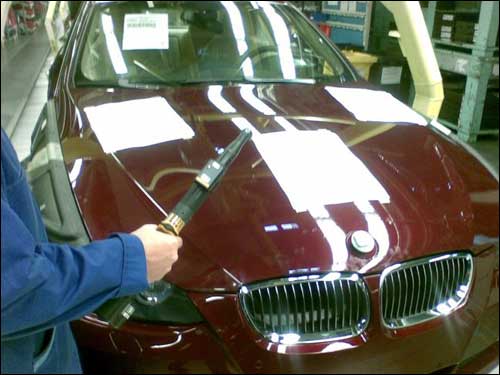BMW is employing an RFID-based real-time location system (RTLS) at its assembly plant in Regensburg, Germany, to match the cars being assembled with the correct tools needed to perform the job, thereby automating a system to provide each vehicle with custom assembly, based on the car’s vehicle identification number (VIN). The RTLS, provided by Ubisense, enables the automobile manufacturer to track the location of each car and tool within 15 centimeters (6 inches) throughout the 2 kilometers (1.2 miles) of the assembly line.
Because BMW’s customers typically order specific customized cars, each vehicle is assembled according to a client’s individual requirements, with specific interiors, seats and engine parts for each order. Providing custom-installation instructions to assembly-line operators has proved challenging for the high-end automaker. Each station along the assembly line, for instance, is afforded approximately 50 seconds to carry out its instructions before the next car takes that vehicle’s place. Operators must know quickly which part is being installed on each car, as well as apply the appropriate torque for that particular installation—when employing a wrench, for example, to tighten bolts.

The company had tested or tried multiple solutions, including passive and active RFID, infrared and bar-coding, to help operators quickly determine which type of assembly each car required as it arrived on the assembly line. Until recently, BMW had settled on a solution in which bar-coded labels were attached to a car’s trunk. Operators would employ a handheld bar-code scanner to read each label’s serial number, which was then sent to the manufacturer’s back-end system, linked to the car’s VIN and assembly requirements.
The operator would then put the scanner down and pick up his or her station’s tool, which would receive instructions from a software application provided by German software firm IBS, and would be automatically programmed to correctly carry out the necessary task, such as operating at a specific torque for applying bolts. This system, however, was too time-consuming and allowed for errors. In some cases, the bar-coded labels simply weren’t read because the operators forgot or lacked sufficient time to do so.
The quality-control department would often identify an incorrectly installed item on a completed car, and send the vehicle back to rectify the problem. The annual cost of such mistakes was as high as €1 million ($1.4 million), says Ubisense’s CEO, Richard Green.
About 18 months ago, Green says, the automaker began discussing an ultra-wideband (UWB) RFID solution with Ubisense. “They were looking for a system with high reliability,” he explains. Ubisense, working together with IBS, developed the BMW Tool Assistance System (TAS), which combines IBS’ tool-controlling software with Ubisense’s RTLS technology to help the car manufacturer locate and identify production assets, vehicles and torque tools at 120 tool stations, where 1,000 vehicles are typically assembled per day.
The system, which was fully deployed in January 2009, enables BMW to identify each vehicle as it moves through the assembly line, and to recognize not only its location to within inches, but all of the tools being used on that car as well. Extreme precision was necessary for pinpointing location, since each vehicle on the line is situated approximately 1 foot behind the one before it, and as many as five tools are often used on a single vehicle at the same time.
When the empty shell of a BMW car enters the assembly process, an employee encodes its VIN onto a Ubisense UWB RFID tag and places that tag—which has a magnetic backing—onto the vehicle’s hood. The tag then transmits the car’s VIN number via a series of short signals (between 6 and 8 GHz). Approximately 380 Ubisense interrogators were installed above the assembly line, capturing the VIN numbers being transmitted by any UWB active tags in their vicinity. This helps the system identify each tag’s location. In addition, the system measures a signal’s angle, in order to better pinpoint a tag’s location. A similar UWB tag is attached to each tool, with a unique ID number that beacons at different rates, depending on whether a particular tool is moving. If the tool remains motionless, it ceases transmitting entirely until someone picks it up.
Once readers capture a tool’s tag ID number, they transmit that data to the back-end system via a cabled connection. The TAS software then integrates the tags’ location with the existing IBS tool-control system, which sends the appropriate instructions to the tools being used on that specific tagged car.
Now that the infrastructure is in place, Green says, the company can use the data for additional purposes as well, such as tracking the location of a vehicle sent back for servicing or adjustments after assembly has been completed. Once the factory’s quality-control department approves a vehicle, the tag is removed and the BMW emblem is placed on the hood. The tag can then be reused on another car.
According to Green, the greatest challenge for the system was ensuring that the tags could be interrogated accurately in a highly metallic environment, as metal can potentially make it harder to read tags. The ability to pinpoint the location of tools and vehicles was critical, he notes, and the large network of UWB readers was able to provide that level of precision. “We’ve learned quite a lot through this installation,” Green states, though Ubisense already had experience deploying a similar tool-tracking application for Caterpillar (see RFID Tightens Up Caterpillar’s Assembly Process). One key lesson, he says, has been the importance of having tagged tools, and Ubisense is now in discussions with several tool manufacturers to embed RFID tags in the tools before they ever reach a customer like BMW.

